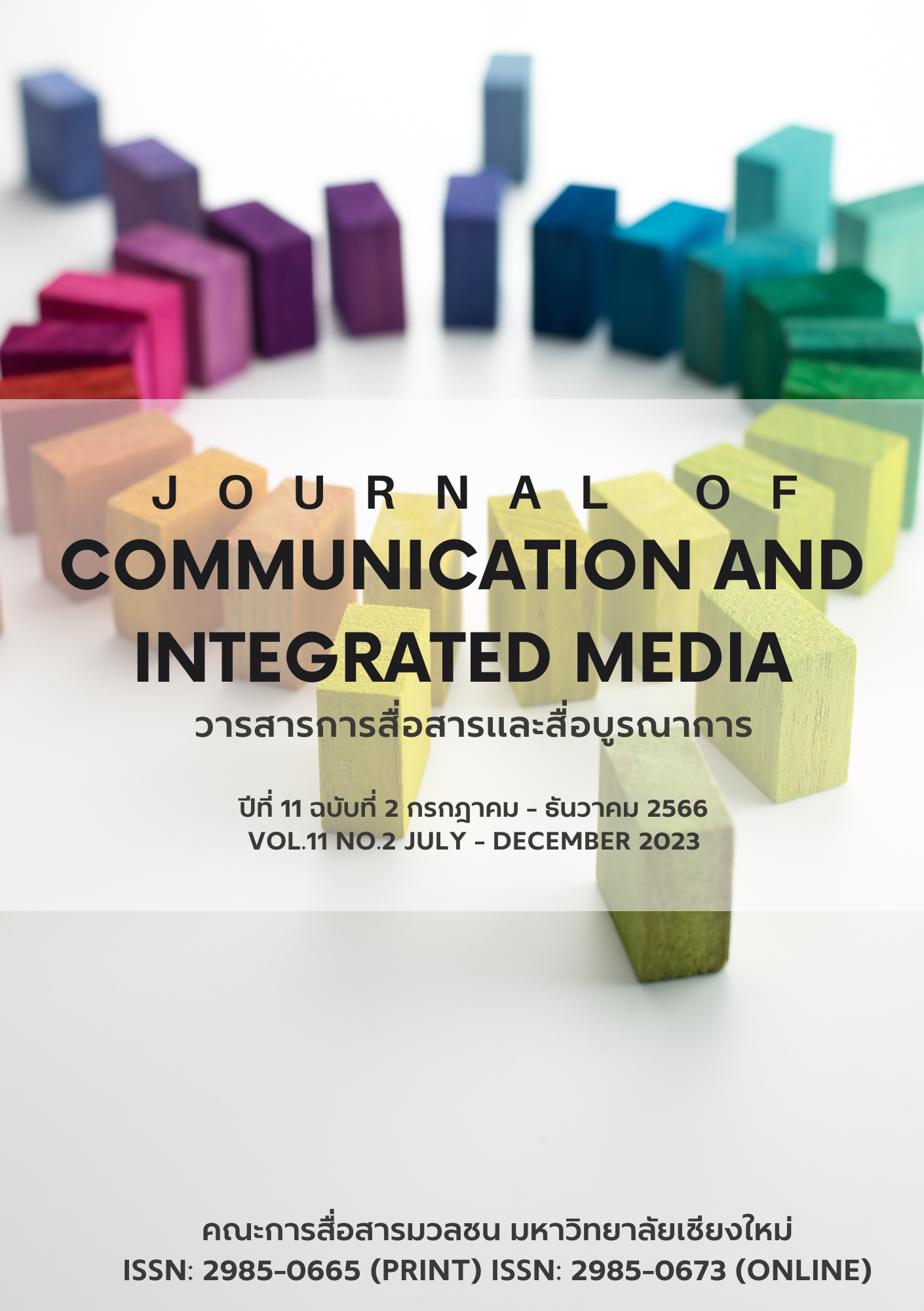Character and Production Process of Film Score that Won Thailand National Film Assocation Awards
Main Article Content
Abstract
The character and production process of film scores that won Thailand National Film Association Awards aims to study the concept, production process, and characteristics of film scores in Thai films that won Thailand National Film Association Awards for Best Original Score from 2010-2022 consisting of 11 films: Yamada, Kon Khon, Echo Planet, Jan Dara 2: The Finale, The Teacher’s Diary, Heart Attack, A Gift, Bad Genius, The Legend of Muay Thai: 9 Satra, Where We Belong, and The Medium. This study used analysis of the characteristics of the film score and in-depth interview with six film score composers who are still active in the film score industry and who won Thailand National Film Association Awards for Best Original Score from 2010-2022 by recruited for semi-structured interview. The results of the study can be divided according to the objectives as follows: The results of the study according to the first objective were to study the concept and production process of film scores in Thai films that won Thailand National Film Association Awards including: (1) film scores are an important element that must be used to support the right timing in order to complete a movie without being so outstanding that it steals the focus of the audience from the images on the screen; (2) the minor scale is mainly found in film scores; (3) the theme music often appears and represents the story of and the characters in the movie; (4) the production process of film scores begins when the composers are given many tools to communicate and allow those involved in the production process to be on the same page. They used the concept and arranged the music before they submitted film scores to producers or directors in order to periodically receive feedback. The editing and testing film scores together with the movie. The results of the study according to the second objective were to analyses the characteristics of film scores in Thai films that won Thailand National Film Association Awards including: using a mixture of Eastern and Western music, using a scale to create theme music and other sound effects.
Article Details

This work is licensed under a Creative Commons Attribution-NonCommercial-NoDerivatives 4.0 International License.
ลิขสิทธ์ที่ผู้เขียนบทความต้องยอมรับ
References
กองบรรณาธิการคัลเจอร์. (2562, 28 กุมภาพันธ์). 28 ปีรางวัลภาพยนตร์แห่งชาติสุพรรณหงส์ กับบทบันทึก ‘ครั้งแรก’ ที่เคยเกิดขึ้นในความทรงจำ. The Standard. https://thestandard.co/28th-thailand-national-film-association-awards/
โกวิทย์ ขันธศิริ. (2558). ดุริยางคศิลป์ตะวันตก เบื้องต้น (พิมพ์ครั้งที่ 2). สำนักพิมพ์แห่งจุฬาลงกรณ์มหาวิทยาลัย.
ณรงค์ ปรางค์เจริญ. (2565, 6 สิงหาคม). Chaotic Noises of Silence Rime. Thailand Phil. https://www.thailandphil.com/wp-content/uploads/2022/08/2022-program-TICF.pdf?fbclid=IwAR3ly-ggJaciUuivNOgJ1stqTbxqtXbfMD84LLqNeVtK1z1egttBYNZQR8
ณัชชา พันธุ์เจริญ. (2564). พจนานุกรมศัพท์ดุริยางคศิลป์. (พิมพ์ครั้งที่ 5). สำนักพิมพ์แห่งจุฬาลงกรณ์มหาวิทยาลัย.
เดอะแบนด์มิวสิคสคูล. (2564, ม.ป.ป.). ดนตรีประกอบภาพยนตร์. https://thebandmusicschool.com/2021/03/21/ดนตรีประกอบภาพยนตร์/
โดม สุขวงศ์. (2555). สยามภาพยนตร์. ลินคอร์น โปรโมชั่น.
ไทย พีบีเอส. (2563, 15 ธันวาคม). เมื่อภาพยนตร์ขาดดนตรีไม่ได้. https://www.thaipbspodcast.com/article/radio/34/เมื่อภาพยนตร์ขาด+“ดนตรี”+ไม่ได้
ธีรเดช แพร่คุณธรรม. (2556). การวิเคราะห์ดนตรีประกอบภาพยนตร์: กรณีศึกษาภาพยนตร์เรื่อง "ปืนใหญ่ จอมสลัด" ประพันธ์โดยชาติชาย พงษ์ประภาพันธ์ [ปริญญานิพนธ์ปริญญามหาบัณฑิต, มหาวิทยาลัยศรีนครินทรวิโรฒ]. Srinakharinwirot University Institutional Repository. http://ir.swu.ac.th/xmlui/handle/123456789/4065?show=full
ธีรพงศ์ เสรีสำราญ. (2563, 14 พฤษภาคม). 10 บทเพลงบันดาลใจจากภาพยนตร์สู่ดนตรี. beartai. https://www.beartai.com/lifestyle/433976
ปรีชา ปิ่นมาโนช (2562, 3 มีนาคม). สองดีเจคู่หูคู่ซี้สร้างสรรค์สังคมบาบาร่าวาวาร่วมงานออสการ์เมืองไทยสุดยิ่งใหญ่ที่ 1 ของคนไทย “สุพรรณหงส์” รางวัลเกียรติยศแห่งวงการภาพยนตร์ไทย. Todayhighlightnews. https://www.todayhighlightnews.com/2019/03/1_3.html?m=1
ปรวัน แพทยานนท์. (2556). ตัวละครและสไตล์การแสดงในบริบทสังคมและวัฒนธรรมไทย : กรณีศึกษาภาพยนตร์ไทยที่ได้รับรางวัลภาพยนตร์สุพรรณหงส์. วารสารสถาบันวัฒนธรรมและศิลปะมหาวิทยาลัยศรีนครินทรวิโรฒ, 14(2), 78-86. https://so02.tci-thaijo.org/index.php/jica/article/view/15169/13911
พงศธร โปษยานนท์. (2560a, พฤศจิกายน). ขั้นตอนการทำดนตรีประกอบภาพยนตร์โดยละเอียดที่คนทำหนังอย่างคุณควรรู้! (1). Pongsathorn Posayanonth. https://www.pongsathornpmusic.com/single-post/the-process-of-film-scoring-1
พงศธร โปษยานนท์. (2560b, พฤศจิกายน). ขั้นตอนการทำดนตรีประกอบภาพยนตร์โดยละเอียดที่คนทำหนังอย่างคุณควรรู้! (2). Pongsathorn Posayanonth. https://www.pongsathornpmusic.com/single-post/the-process-of-film-scoring-2
ไพบูรณ์ คะเชนทรพรรค์. (2548). เสียงในภาพยนตร์. มหาวิทยาลัยสุโขทัยธรรมาธิราช.
วิทยา วรมิตร. (2555). ดนตรีประกอบภาพยนตร์ไทยระหว่างปี พ.ศ. 2542-2552[ปริญญานิพนธ์ปริญญาดุษฎีบัณฑิต]. มหาวิทยาลัยมหิดล.
วิทวัส พลช่วย และ เอกราช เจริญนิตย์. (2563). การศึกษาองค์ประกอบของดนตรีไทยในภาพยนตร์เชิงอนุรักษ์ศิลปวัฒนธรรมไทย [ปริญญานิพนธ์ปริญญามหาบัณฑิต, มหาวิทยาลัยศิลปากร]. DSpace at Silpakorn University. http://ithesis-ir.su.ac.th/dspace/handle/123456789/3368
วิบูลย์ ตระกูลฮุ้น. (2558). ดนตรีศตวรรษที่ 20. สำนักพิมพ์แห่งจุฬาลงกรณ์มหาวิทยาลัย.
วิระชัย ตั้งสกุล และ ภัทรวดี จันทรประภา. (2547). ทฤษฎีและการวิจารณ์ภาพยนตร์. โรงพิมพ์มหาวิทยาลัยสุโขทัยธรรมาธิราช.
ศิริพันธ์ เจริญรัถ. (2561). การทำเพลงประกอบภาพยนตร์และละครโทรทัศน์.http://www.soundstagemag.com/main/index.php/magazinearticles/technology-av-media/1221-2018-10-04-09-14-20
สธน โรจนตระกูล. (2559). ดนตรีนิยม. โอเดียนสโตร์.
อุทัย นิรัติกุลชัย. (2547). ดนตรีประกอบภาพยนตร์ [ปริญญานิพนธ์ปริญญาบัณฑิต]. มหาวิทยาลัยธรรมศาสตร์.
Wierzbicki, J. (2009). Film music: A history. Routledge.
Kalinak, K. (2013). Film music: A very short introduction. Oxford University Press.
Evans, M. (1975). Soundtrack: The music of the movies. Hopkinson and Blake.
Paris, O. (2018, August 27). Know the score: The psychology of film music. Film Independent. https://www.filmindependent.org/blog/know-score-psychology-film-music/
Thomas, T. (1997). Music for the movies (2nd ed.). Silman-James Press.

